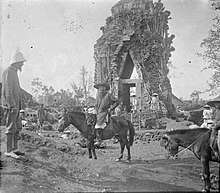Henri Parmentier
Henri Parmentier (French: Henri Ernest Jean Parmentier) was a French architect, art historian and archaeologist.[1] Parmentier became one of the first European specialists in the archaeology of Indochina.[2] He has documented, depicted and preserved many Khmer, Cham and Lao monuments.
Henri Parmentier | |
|---|---|
| Born | January 3, 1870 Paris |
| Died | February 22, 1949 (aged 79) Phnom Penh |
| Alma mater | École nationale supérieure des Beaux-Arts |
| Spouse(s) | Jeanne Leuba |
| Scientific career | |
| Fields | archaeology |
Early years

Henri Ernest was born on 3 January 1870 in Paris; his father was a painter working in Lycée de Reims.[2][3] In 1891 Parmentier entered the École nationale supérieure des Beaux-Arts graduating in 1905 with a diploma in architecture.[1][4] In 1896 he got employed by the colonial administration in Tunisia and over time he developed a profound interest in archaeology.[2] During this period Parmentier created a detailed plan of the Temple of Saturn in Dougga to assist with its restoration.[1] This job was awarded with an honourable mention on the exhibition of Société des Artistes Français.[3] In 1900 Parmentier joined archaeologist Henri Dufour and photograph Charles Carpeaux in the Archaeological mission in Indochina (later renamed École française d'Extrême-Orient).[5] They went to Siam to study Angkor Wat that had been located on its territory.[1] Khmer monuments were largely unknown to the Westerners and almost uncharted. Studying Khmer history became Parmentier's lifework.[4]
In 1902—1905 Parmentier and Carpeaux studied, described, depicted and preserved Cham monuments in Vietnam: a buddhist temple complex Đồng Dương (1902), a Hindu temple complex Mỹ Sơn (1903—1904), the Chánh Lộ temple (1905) -- the latter was studied by Parmentier alone.[1][2][6][4] The study made from the expedition trip to Đồng Dương was presented by Parmentier and Carpeaux at the Congress of the École française d'Extrême-Orient.[1][5] Parmentier studied the architecture of Java in order to compare it to Cham architectural styles.[1][5]
As a head of the École française d'Extrême-Orient

In 1904 Parmentier was appointed the head of the archaeological department of the École; he stayed on this position for 28 years until 1932.[7] Parmentier's duties included defining the main course of the École's work in Cambodia.[3] In 1905 Henri married journalist and writer Jeanne Leuba who travelled with him and took a big part in the fieldwork.[1][8]
Parmentier studied and conserved the Po Nagar Cham temple in 1906—1907.[1][8] During his next expedition to Cambodia Parmentier depicted and restored Khmer monuments in Serei Saophoan, Battambang Province, Siem Reap Province and Angkor, with special attention to Bayon.[1][9] From Cambodia he went to the South of Vietnam and took part in restoring the Po Klong Garai temple (1908).[8][4] In 1913—1914 Parmentier reorganised the museum of the École française d'Extrême-Orient.[1][4] He visited Cambodia from time to time, documenting Angkor and Sambor Prei Kuk (1911); he also visited Kampong Thom city and Banteay Prey Nokor.[4][10] Parmentier studied Chinese tombs in Northern Vietnam in Bắc Ninh Province (Vietnamese: Nghi Vệ), helped creating a permanent exhibition for the Museum of Cham Sculpture that was under construction in Da Nang—in 1936 the museum was renamed after him.[1][11] He directed the École in 1918—1920.[12] In 1920 Parmentier received an award for his book on Cham architecture.[3]
Parmentier visited the ruins of the Lao temple complex Vat Phou,[12] he paid special attention to Krol Roméas (Phnom Kulen plateau), Angkor and the Bayon temple in particular, which he helped reconstructing.[4][13] His collaboration with Louis Finot and Victor Golubev on Banteay Srei, a Khmer temple complex, was published as a book in 1926.[4][13]
After retirement
_(5048751186).jpg)
Parmentier retired in 1932 aged 62. He left his position at the École, received a title of the honorary head of the archaeological department and moved to Phnom Penh.[3][13] Despite being retired, Parmentier continued his fieldwork and his research working on a descriptive list of important monuments in Laos and a book titled "The Art of Laos" that he left unfinished.[1][13][3] He had created a draft of a tourist guidebook on Angkor monuments, which was published posthumously.[13] Parmentier died on 22 February 1949 in Phnom Penh.[2]
Selected works
- Parmentier, Henri (1909–1918). Inventaire descriptif des monuments cams de l’Annam.
- Parmentier, Henri (1927). L’Art khmer primitif.
- Parmentier, Henri (1939). L’Art khmer classique: Monuments du quadrant nord-est.
- Parmentier, Henri (1954). L’Art du Laos.
Notes
- Oxford.
- Obituary 1952, p. 273.
- Pouillon 2012, p. 783.
- EFEO.
- Obituary 1952, p. 274.
- Pouillon 2012, p. 783–784.
- BnF.
- Obituary 1952, p. 275.
- Obituary 1952, p. 273–275.
- Obituary 1952, p. 274–276.
- Pouillon 2012, p. 783–785.
- Obituary 1952, p. 276.
- Obituary 1952, p. 277.
References
- Parmentier, Henri. Grove Art Online. Oxford University Press. (subscription required)
- "Henri Parmentier (1870—1949)". Bulletin de École française d'Extrême-Orient (in French). 45 (2). 1952. pp. 272–283.
- "Henri Parmentier (1871-1949)" (in French). Bibliothèque nationale de France. Retrieved 2017-10-12.
- Pouillon, François (2012). Dictionnaire des orientalistes de langue française. Lettres du Sud (in French). IISMM. p. 1073. ISBN 9782811107901.
- "Henri Parmentier" (in French). École française d'Extrême-Orient. Retrieved 2017-10-13.